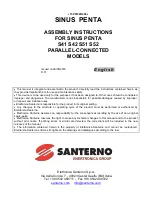
ASSEMBLY
INSTRUCTIONS
PARALLEL-CONNECTED
SINUS PENTA MODELS
12/
24
4.1.
Components, Wiring and Sizes of the Protective Devices
The components required for the parallel connection of the Sinus Penta drives are given in the tables below.
The minimum requirements of the inverter cables and the protective devices needed to protect the system
against short-circuits are also given in the tables below. It is however recommended that the applicable
regulations in force be observed; also, check if voltage drops occur for cable links longer than 100m.
For the largest inverter sizes, special links with multiple conductors are provided for each phase. For
example, 2x150 in the column relating to the cable cross-section means that two 150mm
2
parallel conductors
are required for each phase.
Multiple conductors shall have the same length and must run parallel to each other, thus ensuring even
current delivery at any frequency value. Paths having the same length but a different shape deliver uneven
current at high frequency.
Also, do not exceed the tightening torque for the terminals to the bar connections. For connections to bars,
the tightening torque relates to the bolt tightening the cable lug to the copper bar. The cross-section values
given in the tables below apply to copper cables.
The links between the motor and the SINUS PENTA drive must have the same lengths and must follow the
same paths. Use 3-phase cables where possible:
1. N.1 safety device on the supply mains to the parallel-connected drives.
2. N.1 safety device on the supply mains to each drive that is parallel-connected to the other drives.
3. N.1 input inductor to the supply mains to each drive that is parallel-connected to the other drives. The
inductor is utilized to split the supply current.
4. N.1 output inductor between each parallel-connected drive and the motor. The inductor is utilized to split
output current.
The parallel connection of the motor cables is to be done directly to the motor terminals as shown in Figure
4, in order to get even better current splitting.
NOTE
The notes below are general-purpose guidelines that cannot be applied to
any configuration. The component dimensioning shall meet the
environmental requirements as well as the requirements of the place where
the equipment is installed.
























